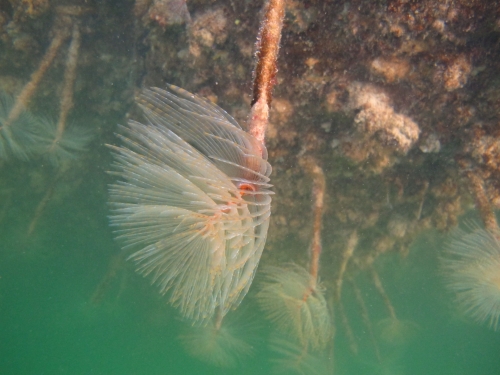I want to...
Current filter: Most popular
A to Z
Apply for a job
Biosecurity
Consents
Consultation
Contact Us
Environmental Data
Farmers Hub
Fix it or Report it
Information Request
Join an Event
Leasehold Land
Meetings
Rates
Water Metering
Have Your Say
Ahuriri Harbour Clear of Unwanted Marine Pests
Published: 14 March 2019

Photo, credit Northland Regional Council - Mediterranean fanworm
A dive survey of the Ahuriri Inner Harbour recently has given an ‘all clear’ on marine pests that we don’t want to see in Hawke’s Bay coastal waters.
Hawke’s Bay Regional Council Biosecurity contracted the Bay of Plenty Regional Council dive team to check hulls, piles and underwater structures in the harbour in late February.
“Fortunately they have found no sign of pests we don’t want here, but boaties and harbour management have to stay alert to the risks,” says Marine Biosecurity advisor Alice McNatty.
“The worst marine pests we definitely don’t want to get in Hawke’s Bay waters are Mediterranean fanworm (Sabella spallanzanii) and Clubbed tunicate (Styela clava). They have the ability to spoil our underwater marine reefs that are important for fish and other species.”
The new Regional Pest Management Plan that was implemented on 1 February 2019 and specifies these creatures as Exclusion Pests – in other words, they aren’t found here and they need to be kept out of Hawke’s Bay waters. They have established in some areas in New Zealand, but are not known to be present in the waters of Hawke’s Bay, although the risk of them getting here remains.
The Mediterranean fanworm and Clubbed tunicate can both form colonies of very high densities competing with native species for food and space. Their impact on native species and habitats means they pose a significant risk to Hawke’s Bay underwater reefs, and to commercial and recreational fishing, and shellfish harvesting.
The main way these are spread into new locations is through hull fouling on boats.
Regional Pest Management Plan has a new ‘clean hull’ rule. This rule states that an operator of a vessel entering Hawke’s Bay regional waters must ensure the hull is sufficiently cleaned and anti-fouled so that there is no more than a slime layer and/or goose barnacles.
This rule also applies to any structure or navigation aid entering Hawke’s Bay’s waters.
If anyone thinks they have seen one of these creatures on a boat or structure, they can contact Alice McNatty at the regional council on 0800 108 838 with details and even photos.
Because Mediterranean fanworm and Clubbed tunicate have been declared as Exclusion Pests, it allows the Regional Council to act immediately if either of these species are found within Hawke’s Bay Regional Council waters.
The next survey of the Napier Inner Harbour for marine pests will be in 2 years time.
Information on these marine pests is available at hbrc.govt.nz search #marinepests, with a description of how they can be identified compared to native species.
Disclaimers and Copyright
While every endeavour has been taken by the Hawke's Bay Regional Council to ensure that the information on this website is
accurate and up to date, Hawke's Bay Regional Council shall not be liable for any loss suffered through the use, directly or indirectly, of information on this website. Information contained has been assembled in good faith.
Some of the information available in this site is from the New Zealand Public domain and supplied by relevant
government agencies. Hawke's Bay Regional Council cannot accept any liability for its accuracy or content.
Portions of the information and material on this site, including data, pages, documents, online
graphics and images are protected by copyright, unless specifically notified to the contrary. Externally sourced
information or material is copyright to the respective provider.
© Hawke's Bay Regional Council - www.hbrc.govt.nz / +64 6 835 9200 / info@hbrc.govt.nz


